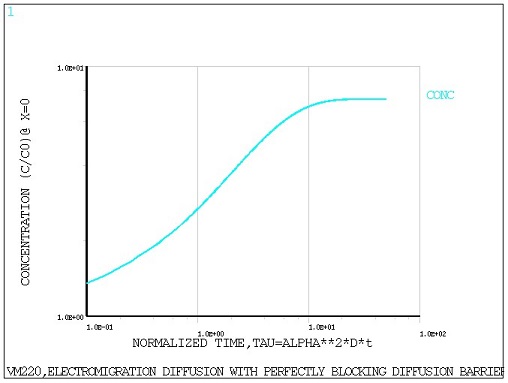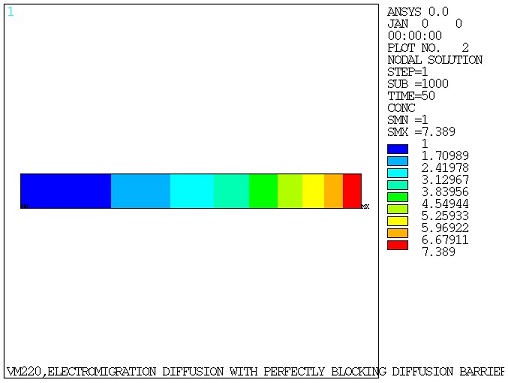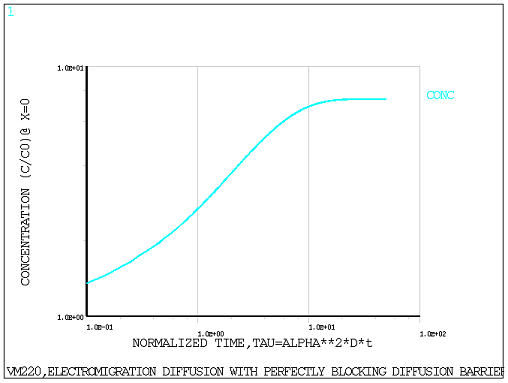VM220
VM220
Electromigration Diffusion Problem with Perfectly Blocking Diffusion
Barrier
Overview
Test Case
Diffusion and mass transport effects due to electromigration are considered in a rectangular conductor of length L and height H. A concentration load of C0 is applied at one end of the plate (x = -L) and a zero diffusion flux boudary condition (blocking diffusion barrier) is applied at the other end (x = 0) of the plate. A transient analysis is performed to determine the concentration evolution at the blocking diffusion end of the plate.
| Material Properties | Geometric Properties | Loading | ||
|---|---|---|---|---|
|
Analysis Assumptions and Modeling Notes
Two approaches are used to solve this boundary value problem. The first solution uses a diffusion element type (PLANE238) and applies the electromigration driving force ALPHA as transport velocity body load (BF, VELO). The second approach uses a coupled electric-diffusion element type (PLANE223 with KEYOPT(1) = 100100) in conjunction with a Migration Model (TB,MIGR). The Migration Model is used to define the effective electric charge Z*e, which determines the direction and magnitude of the electron-atom momentum exchange responsible for the mass transport of atoms due to the electric current. The voltage DOFs are constrained at location x = 0 and a voltage load of V0 is applied at node 1 in order to achieve the desired electromigration driving force ALPHA.
Transient diffusion and electric-diffusion analyses with stepped loading (KCB,1) are performed with an end time = 50 seconds and a time increment of 0.05 seconds to determine the concentration at the blocking boundary x = 0 for all time points. Initial concentration C0 = 1 is imposed using the IC command. The obtained results are then compared against the reference solution (Figure 1, C (-L, t) = C0, alpha*L = 2).
Results Comparison
The calculated concentration is compared to the target results at the blocking boundary (x = 0) for several normalized time points.
| Normalized Time | Target | Mechanical APDL | Ratio |
|---|---|---|---|
| Concentration values using PLANE238 elements | |||
| 0.01 | 1.11 | 1.25 | 1.13 |
| 1 | 2.70 | 2.71 | 1.00 |
| 10 | 6.69 | 6.89 | 1.03 |
| 39.5 | 7.35 | 7.39 | 0.99 |
| Concentration values using PLANE223 elements | |||
| 0.01 | 1.11 | 1.17 | 1.05 |
| 1 | 2.70 | 2.69 | 0.99 |
| 10 | 6.69 | 6.89 | 1.03 |
| 39.5 | 7.35 | 7.39 | 0.99 |
The calculated concentration at the blocking barrier (x = 0) as a function of normalized
time is shown in the following figures for PLANE238 and
PLANE223 elements respectively.






